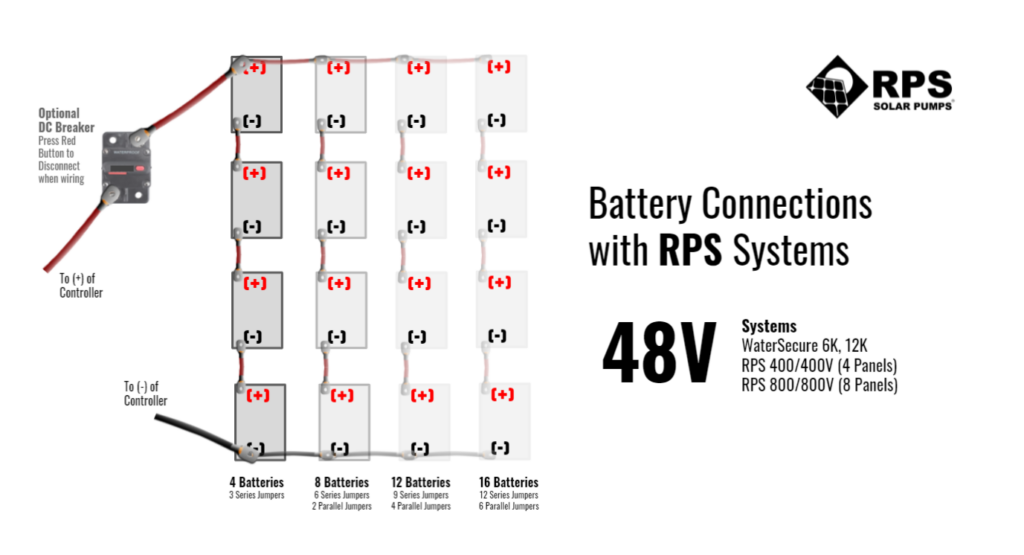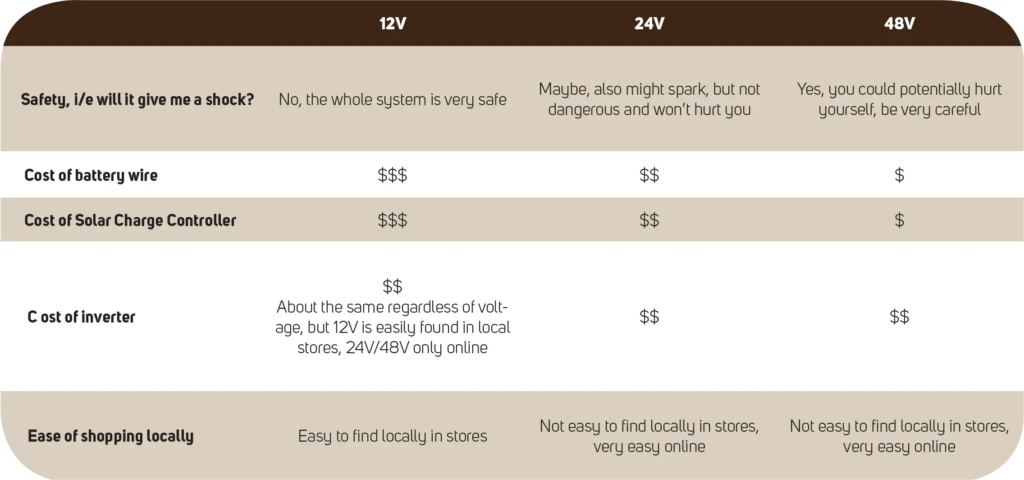The Future of Off Grid Storage: 48V Battery Banks
Off grid solar systems have been around for a long time, and the original standard systems were almost all 12V. We get a lot of customers wondering why our systems are all at least 24V or 48V, since they’re used to 12V as the standard of RV’s and off grid houses. For small systems, we can agree that 12V might still be ideal, but for medium to large projects consumers are transitioning over to using 24V or 48V for cost effective, more efficient setups (made possible by readily available 24V and 48V controllers from the online marketplace).
RPS 24V systems: TPP, RPS 200, Watersecure 3k

RPS 48V systems: RPS 400, RPS 800, RPS 400N, Watersecure 6k and Watersecure 12k

12V Makes Charging Electronics Easy – But There’s a Limit
These days you can easily buy 12V appliances like fridges, freezers, vacuums, fans, phones, laptops, coffee makers, lights and radios. Any car cigarette lighter socket-plug can be used to power the same items, because car electrical systems are also 12V. For those people who only need to power a handful of appliances, consume low amounts of power or own a solar array of less than 300W, 12V gets the jobs done
In comparison, you can not run 12V appliances directly on a 24V system. You’ll need to buy a converter to step down the voltage from 24V to 12V. Converters cost $30-40 with overcurrent and temperature protection features.
What about charging batteries? Using a vehicle to recharge a 24V or 48V battery bank is difficult because you can’t charge a 24V battery with an alternator. A converter or battery charger with a battery isolator would be needed, but this option is complex and not generally suggested by our engineers.

Batteries Prefer 24V and 48V
24V and 48V systems battery banks are expanded first by adding units in series before adding a second or third string of batteries in parallel. In contrast, 12V battery banks can only expand by adding units in parallel.
When more than 3 batteries are connected in parallel, one unit may start feeding another and cause one of the batteries to die, leading to early replacement. Issues with a 12V system will most likely occur within 3-5 years, but depends on environmental factors. A Tesla battery has fuses on their parallel batteries for this reason.
All system components of a solar pump like to be at a higher voltage. Higher voltage means less work for charge controller, slightly higher efficiency and less wire loss.

A Safer Option: All-in-One 48V Systems
A DIY set-up, with internal parts sourced from different places, is potentially dangerous for newbies. Extreme care should be taken to ensure that all parts, especially live wires, are covered. An all-in-one system like the RPS Watersecure already has all components built into a self-contained box. All the customer has to do is plug in batteries and solar panels (plug and play MC4 connectors), and the chance of shock is practically impossible. As long as you arrange your batteries properly (see diagram), all-in-one off grid systems are near foolproof.


Cost Breakdown
Wire Cost
Wire will cost less for 24V and 48V systems! As batteries and panels are added in parallel for 12V systems, and the amperage of the system increases, and wire gauge needs to increase proportionally. Amperage in a 12V system is DOUBLE that of a 24V system, meaning copper wire should be twice as thick for a 12V system. Copper wire isn’t cheap, you might end up spending a good chunk of change on thicker wire to achieve a less powerful 12V setup rather than reconfiguring to a 24V or 48V array.
Charge Controller Cost
Charge controller are rated in amps. Using similar reasoning as wire gauge, a 24V system can get away with half the charge controller size as a 12V system. A smaller charge controller will limit the number of panels, and in turn watts, a system can handle.
Example:
20 Amp MPPT charge controller 260W max w/ 12V battery bank
OR
520W w/ 24V battery bank
Inverter Cost
Whether using 12V, 24V or 48V, inverters will cost about the same. However, 12V has some advantage here since sourcing the lower voltage option locally is much easier than finding 24V or 48V inverters in your town hardware store. You’ll find plenty of choices for 24V or 48V through a quick internet search.
